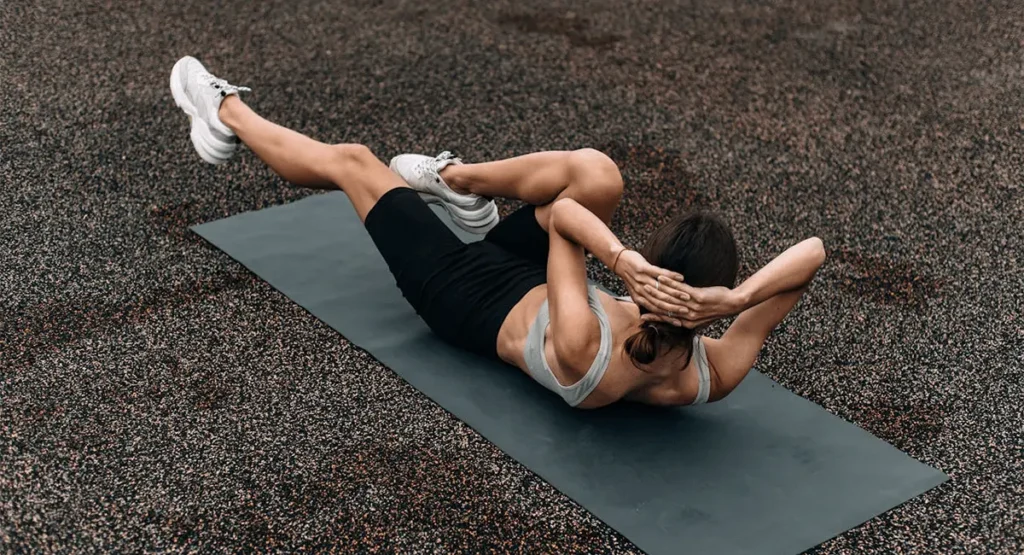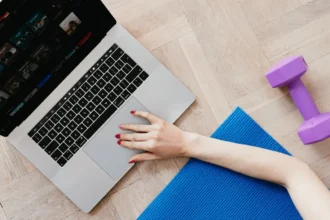
Finding time for fitness can feel impossible with packed schedules, long commutes, and endless responsibilities. Yet what if we told you that just 10 minutes of targeted ab exercises could transform your core strength and overall fitness? Home ab workouts eliminate every excuse: no gym membership fees, no travel time, and no intimidating equipment.
These quick core exercises fit seamlessly into any daily routine, whether you’re a busy parent, working professional, or fitness beginner.
In this comprehensive guide, you’ll discover five proven 10-minute ab workout routines that require zero equipment. Each routine targets different fitness levels and goals, from gentle beginner circuits to intense advanced challenges. Plus, you’ll learn proper form techniques, safety guidelines, and realistic expectations for building stronger abs at home.
Also read: How to Start Working Out: Complete Beginner’s Guide to Fitness (2025)
Why 10-Minute Ab Workouts Are Effective
Research from the American Council on Exercise demonstrates that short, high-intensity workouts can be just as effective as longer sessions when performed consistently. Your core muscles respond exceptionally well to frequent, focused training because they’re designed for endurance and stability rather than just strength.
The beauty of 10-minute ab workouts lies in their sustainability. While hour-long gym sessions might happen once or twice weekly, a quick daily core routine becomes an achievable habit. According to fitness physiologists, consistent daily practice creates better neuromuscular adaptations than sporadic longer workouts.
Core strength impacts every aspect of daily movement, from lifting groceries to maintaining good posture at your desk. Strong abdominal muscles support your lower back, improve balance, and enhance athletic performance in other activities. Many people mistakenly believe that effective ab training requires lengthy sessions, but studies show that muscle fatigue and activation can occur within minutes when exercises are performed correctly.
Short workouts also provide mental benefits. Completing a 10-minute routine creates a sense of accomplishment without feeling overwhelming, making it easier to maintain motivation long-term.
What You’ll Need
The best part about home ab workouts is their simplicity. These routines require absolutely no equipment, making them accessible whether you’re in a small apartment, hotel room, or outdoor space. All exercises use your body weight for resistance, proving that effective core training doesn’t need fancy machines or expensive gear.
For enhanced comfort, consider using a yoga mat or thick towel to cushion your back during floor exercises. However, even carpet or a folded blanket works perfectly fine. You’ll need approximately 6 feet by 3 feet of clear floor space, though many exercises can be modified for even smaller areas.
Wear comfortable, breathable clothing that allows full range of motion. Avoid restrictive jeans or belts that might dig into your waist during twisting movements. Athletic shoes are optional since most exercises are performed lying down or in stationary positions.
Keep a water bottle nearby to stay hydrated, especially during higher intensity circuits. Having a timer or smartphone app helps track exercise intervals and rest periods accurately.
The 5 Best 10-Minute Ab Workout Routines
Beginner-Friendly Circuit
Perfect for fitness newcomers or those returning after a break, this gentle introduction focuses on basic movement patterns and proper form development.
Plank Hold (30 seconds)
Start in a push-up position with forearms on the ground. Keep your body straight from head to heels, engaging your core muscles. Avoid letting your hips sag or pike upward. If 30 seconds feels challenging, begin with 15-second holds and gradually increase duration.
Modified Crunches (1 minute)
Lie on your back with knees bent and feet flat on the floor. Place hands behind your head without pulling on your neck. Slowly lift your shoulder blades off the ground while exhaling, then lower with control. Focus on using your abdominal muscles rather than momentum.
Dead Bug (1 minute each side)
Lying on your back, lift your arms toward the ceiling and bend your knees to 90 degrees. Slowly lower your right arm overhead while extending your left leg, keeping your lower back pressed to the floor. Return to starting position and switch sides. This exercise teaches core stability while moving your limbs.
Wall Sit with Core Engagement (30 seconds)
Stand with your back against a wall, then slide down until your thighs are parallel to the floor. While holding this position, focus on pulling your belly button toward your spine. This combines leg strength with core activation.
Take 30-second rest periods between exercises. Complete this circuit twice for a full 10-minute workout. As you progress, extend exercise durations or add a third round.
Intermediate Core Blaster
Once you’ve mastered basic movements, this intermediate routine adds dynamic exercises and increases intensity.
Bicycle Crunches (1 minute)
Lie on your back with hands behind your head. Bring your right elbow toward your left knee while extending your right leg, then switch sides in a cycling motion. Keep the movement controlled and avoid yanking on your neck. This exercise targets both your rectus abdominis and obliques.
Russian Twists (1 minute)
Sit with knees bent and feet slightly off the ground. Lean back to create a V-shape with your torso and thighs. Rotate your torso left and right, touching the ground beside your hips with your hands. For added challenge, lift your feet higher or hold the position longer.
Mountain Climbers (45 seconds)
Start in a plank position. Quickly alternate bringing each knee toward your chest as if running in place. Maintain a straight back and engage your core throughout. This exercise combines cardiovascular conditioning with core strengthening.
Leg Raises (45 seconds)
Lie flat with hands at your sides or under your lower back for support. Keeping your legs straight, slowly lift them to 90 degrees, then lower them without touching the floor. This targets your lower abdominal muscles effectively.
Plank to Downward Dog (30 seconds)
From plank position, push your hips up and back into downward dog pose, then return to plank. This dynamic movement engages your entire core while adding flexibility benefits.
Rest 15 seconds between exercises. Complete two full rounds for your 10-minute session.
Advanced High-Intensity Circuit
This challenging routine combines strength, cardio, and core stability for maximum results in minimal time.
Burpees with Push-up (45 seconds)
From standing, drop into a squat, jump back to plank position, perform a push-up, jump feet back to squat, then jump up with arms overhead. This full-body movement intensely activates your core while elevating your heart rate.
V-ups (1 minute)
Lie flat with arms extended overhead. Simultaneously lift your legs and torso, reaching your hands toward your toes to form a V-shape. Lower with control and repeat. This advanced exercise requires significant core strength and coordination.
Plank Jacks (45 seconds)
Hold a plank position while jumping your feet apart and together like jumping jacks. Keep your core tight and avoid bouncing your hips. This adds cardio intensity while challenging core stability.
Single-leg Glute Bridges (30 seconds each side)
Lie on your back with one knee bent and the other leg extended. Lift your hips by squeezing your glutes while keeping your core engaged. This exercise strengthens your posterior chain while requiring core stability.
Bear Crawl Hold (30 seconds)
Start on hands and knees, then lift your knees 2 inches off the ground. Hold this position while maintaining a neutral spine and engaged core. This isometric exercise builds incredible core endurance.
Take minimal rest (10 seconds) between exercises. Complete two rounds with a 1-minute rest between circuits.
No-Equipment Core Crusher
This routine proves you can build serious core strength using only your body weight, perfect for travel or small spaces.
Hollow Body Hold (30 seconds)
Lie on your back and simultaneously lift your shoulders and legs off the ground, creating a banana shape. Press your lower back into the floor while holding this challenging position. This exercise mimics the core position used in gymnastics.
Reverse Crunches (1 minute)
Lying on your back with knees bent, use your lower abs to pull your knees toward your chest while lifting your hips slightly off the ground. This targets the often-neglected lower abdominal region.
Side Planks (30 seconds each side)
Lie on your side and prop yourself up on your forearm. Lift your hips to create a straight line from head to feet. This exercise specifically targets your obliques and improves lateral core stability.
Superman Holds (45 seconds)
Lying face down, simultaneously lift your chest and legs off the ground while squeezing your glutes and lower back muscles. This strengthens your posterior core, which balances front-loaded ab exercises.
Flutter Kicks (1 minute)
Lying on your back with hands under your lower back for support, lift your legs slightly off the ground and alternate small, quick kicks. Keep your core engaged throughout this challenging endurance exercise.
Rest 20 seconds between exercises and complete two full rounds.
Quick Morning Energizer
Start your day with this gentle yet effective routine that combines core activation with mobility work.
Cat-Cow Stretches (30 seconds)
On hands and knees, alternate between arching your back (cow) and rounding it (cat). This warms up your spine while gently engaging your core muscles.
Standing Oblique Crunches (45 seconds each side)
Stand with feet hip-width apart. Bring your right elbow down toward your right knee while lifting your knee up. This standing exercise activates your obliques without requiring floor space.
Standing Knee-to-Elbow (1 minute)
From standing position, alternate bringing opposite knees and elbows together across your body. This dynamic movement wakes up your entire core while improving coordination.
Standing Side Bends (45 seconds each side)
With hands on hips, lean directly to one side while keeping your core engaged. Return to center and repeat on the other side. This targets your lateral core muscles.
Deep Breathing with Core Engagement (30 seconds)
Stand tall and take slow, deep breaths while consciously engaging your core muscles with each exhale. This connects your breathing with core activation, a fundamental skill for all exercises.
Complete this circuit twice with minimal rest between exercises for an energizing 10-minute morning routine.
Proper Form and Safety Tips
Quality always trumps quantity when performing ab exercises at home. Rushing through movements or using poor form not only reduces effectiveness but also increases injury risk. Focus on controlled, deliberate movements rather than speed or repetition count.
The most common mistake in ab training is pulling on the neck during crunching movements. Instead, imagine holding a small orange between your chin and chest, maintaining that space throughout the exercise. Your hands should lightly support your head without providing lifting force.
Proper breathing enhances exercise effectiveness significantly. Generally, exhale during the exertion phase (when muscles contract) and inhale during the release phase. For example, exhale as you crunch up and inhale as you lower down. This breathing pattern helps activate deeper core muscles.
Never ignore pain during exercise. Muscle fatigue and slight burning sensations are normal, but sharp, shooting, or persistent pain indicates a problem. Stop immediately if you experience discomfort in your lower back, neck, or any joint.
Beginners should start with shorter exercise durations and longer rest periods. There’s no shame in modifying exercises or taking extra breaks. Your fitness level will improve gradually with consistent practice.
Always maintain neutral spine alignment during floor exercises. Press your lower back gently into the ground during supine exercises, and avoid excessive arching or rounding. This protects your spine while maximizing core muscle activation.
Creating Your Weekly Routine
Consistency beats intensity when building core strength through home workouts. Begin with three sessions per week, allowing rest days between workouts for muscle recovery and adaptation. According to the American College of Sports Medicine, this frequency provides optimal strength gains for beginners.
As your fitness improves, you can increase frequency to five or six days per week. Advanced practitioners often benefit from daily core training since abdominal muscles recover more quickly than larger muscle groups like legs or chest.
Progressive overload applies to bodyweight exercises just like weighted training. Increase difficulty by extending exercise durations, reducing rest periods, or advancing to more challenging variations. For example, progress from knee planks to full planks, then to single-arm planks.
Combine your ab workouts with other forms of exercise for comprehensive fitness. Cardiovascular activities like walking, running, or cycling complement core training beautifully. Strength training for your upper and lower body creates balanced muscle development.
Track your progress using a simple workout journal or smartphone app. Note exercise durations, difficulty levels, and how you feel after each session. This data helps identify improvements and maintains motivation during challenging periods.
Schedule your workouts at consistent times to build lasting habits. Whether you prefer morning energy boosts or evening stress relief, regularity matters more than perfect timing. Many people find that morning workouts provide sustained energy throughout the day.
Maximizing Your Results
While ab exercises strengthen and tone your core muscles, visible abs depend largely on overall body fat percentage. According to fitness professionals, men typically need body fat below 15% and women below 20% to see defined abdominal muscles. This requires combining exercise with proper nutrition.
Focus on whole foods including lean proteins, vegetables, fruits, and complex carbohydrates while limiting processed foods, excessive sugar, and refined grains. Creating a moderate caloric deficit through diet and exercise promotes fat loss while preserving muscle mass.
Hydration plays a crucial role in both performance and results. Proper hydration helps muscle function, reduces bloating, and supports metabolic processes. Aim for clear or light yellow urine as a hydration indicator.
Sleep significantly impacts your core training results. According to the National Sleep Foundation, inadequate sleep disrupts hormones that regulate hunger and metabolism, making it harder to achieve visible abs. Prioritize 7-9 hours of quality sleep nightly.
Stress management affects abdominal fat storage since chronic stress elevates cortisol levels, promoting belly fat accumulation. Incorporate stress-reduction techniques like meditation, yoga, or simply enjoying hobbies you love.
Be patient with visible results while celebrating functional improvements. You’ll likely notice increased core strength, better posture, and reduced back pain weeks before seeing muscle definition. These functional benefits are arguably more valuable than appearance changes.
Consider adding other core-challenging activities to your routine. Swimming, yoga, Pilates, and rock climbing all engage your core in different ways, preventing adaptation plateaus and maintaining exercise enjoyment.
Common Mistakes and How to Avoid Them
Repeating the same workout routine indefinitely leads to adaptation plateaus where progress stalls. Your muscles adapt to familiar movement patterns, requiring new challenges for continued improvement. Rotate between different workout styles weekly or monthly to maintain progression.
Many people focus exclusively on front abdominal muscles while neglecting their back muscles. This imbalance can contribute to poor posture and lower back pain. Include exercises like supermans, bird dogs, and reverse flies to strengthen your posterior core and create balanced development.
Unrealistic expectations about timeline and results create frustration and abandonment of good habits. Core strength improvements typically become noticeable within 2-4 weeks, but visible muscle definition depends on individual body fat levels and genetics. Focus on how you feel rather than just how you look.
Skipping warm-up and cool-down phases increases injury risk and reduces exercise effectiveness. Spend 2-3 minutes before your workout doing gentle movements like arm circles, leg swings, or light stretching. After your workout, hold static stretches for major muscle groups for 30 seconds each.
Training through pain or excessive fatigue can lead to injury and setbacks. Your body needs recovery time to adapt and grow stronger. If you feel overly sore, tired, or notice declining performance, take an extra rest day. Quality training with adequate recovery beats quantity every time.
Neglecting other aspects of fitness while obsessing over abs creates imbalanced development. Core strength supports all other movements, but you also need cardiovascular fitness, flexibility, and full-body strength for optimal health and function.
Frequently Asked Questions
How often should I do 10-minute ab workouts?
Beginners should start with 3-4 sessions per week, allowing rest days between workouts for proper muscle recovery. As your core strength improves, you can increase frequency to 5-6 times per week or even daily. Advanced practitioners often train abs daily since core muscles recover more quickly than larger muscle groups. Listen to your body and avoid training if you’re experiencing significant soreness or fatigue.
Can I get a six-pack with just 10 minutes a day?
While 10-minute daily ab workouts will significantly strengthen your core muscles, visible six-pack abs depend primarily on your body fat percentage. Men typically need body fat below 15% and women below 20% to see defined abdominal muscles. This requires combining regular ab exercises with cardiovascular training and proper nutrition to reduce overall body fat. Consistency with your 10-minute routine will build the muscle foundation, but diet plays the larger role in revealing those muscles.
Are 10-minute ab workouts suitable for beginners?
Absolutely! The beginner-friendly circuit included in this guide is specifically designed for fitness newcomers. Start with shorter exercise durations and longer rest periods if needed. Most exercises can be modified to match your current fitness level. For example, perform planks on your knees instead of toes, or do crunches with a smaller range of motion. Progress gradually by extending exercise times and reducing rest periods as you get stronger.
What’s the best time of day to do ab workouts?
The best time is whenever you can be most consistent. Some people prefer morning workouts for sustained energy throughout the day, while others find evening sessions help relieve work stress. Morning workouts can boost metabolism and provide mental clarity, but evening sessions won’t interfere with sleep if completed at least 2-3 hours before bedtime. Choose a time that fits your schedule and stick with it to build a lasting habit.
Can I do these workouts if I have lower back pain?
If you have existing lower back issues, consult with a healthcare professional before beginning any exercise program. Many ab exercises can actually help reduce lower back pain by strengthening supporting muscles, but proper form is crucial. Focus on exercises that maintain neutral spine alignment, such as planks and dead bugs. Avoid exercises that cause discomfort and consider modifications like keeping one foot on the ground during single-leg movements.
Do I need any equipment for these workouts?
These routines are designed to be completely equipment-free, using only your body weight for resistance. You might find a yoga mat or towel more comfortable for floor exercises, but even carpet works fine. All exercises can be performed in a small space with no special gear required. This makes the workouts perfect for home, travel, or any location where gym equipment isn’t available.
How long before I see results?
You’ll likely notice improved core strength and endurance within 2-4 weeks of consistent training. Functional benefits like better posture, reduced back pain, and improved balance often appear even sooner. Visible muscle definition depends on your starting body fat percentage and overall lifestyle habits. With proper nutrition and consistent exercise, most people begin seeing some muscle definition within 6-8 weeks, though individual results vary significantly.
Can I combine these with other workouts?
These ab workouts complement other forms of exercise excellently. You can perform them on the same day as cardio workouts, strength training, or other activities. Many people add a 10-minute ab routine after their main workout as a finishing touch. If combining with intense full-body workouts, consider reducing the ab workout intensity or duration to avoid overtraining. The key is listening to your body and ensuring adequate recovery between sessions.
Conclusion
Transform your core strength and overall fitness with just 10 minutes of daily commitment. These equipment-free ab workouts prove that effective training doesn’t require expensive gym memberships or complicated equipment. Whether you’re a complete beginner or advanced fitness enthusiast, there’s a routine here that matches your current abilities and challenges you to improve.
Remember that consistency beats perfection every time. Start with the beginner circuit if you’re new to exercise, and don’t worry about completing every second or performing every repetition perfectly. Your strength and endurance will improve naturally with regular practice.
The most important step is simply beginning. Choose one of these five routines that appeals to you and commit to trying it for just one week. Set a recurring reminder on your phone, lay out comfortable workout clothes the night before, and remember that every expert was once a beginner.
Your future self will thank you for the 10 minutes you invest in building a stronger, healthier core today. These quick home ab workouts are more than just exercises; they’re an investment in better posture, reduced back pain, improved athletic performance, and increased confidence in your daily activities.





